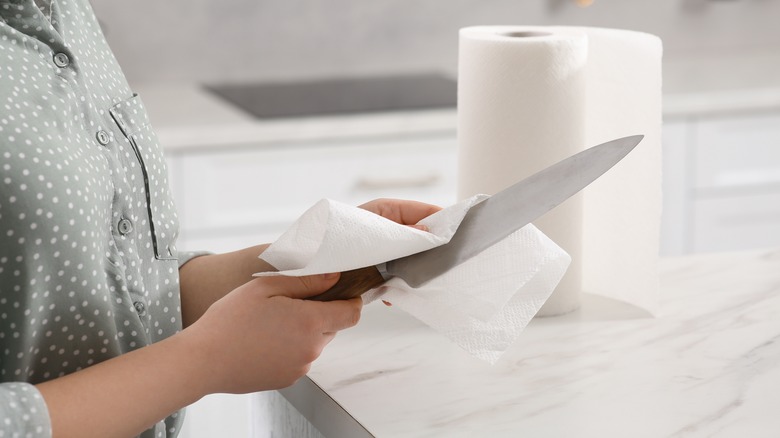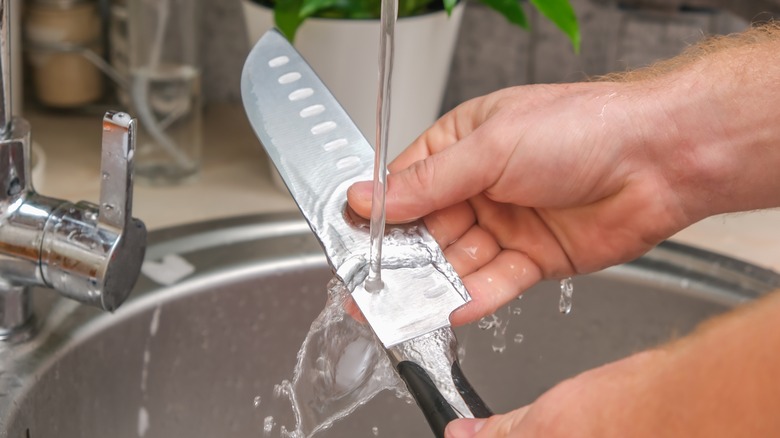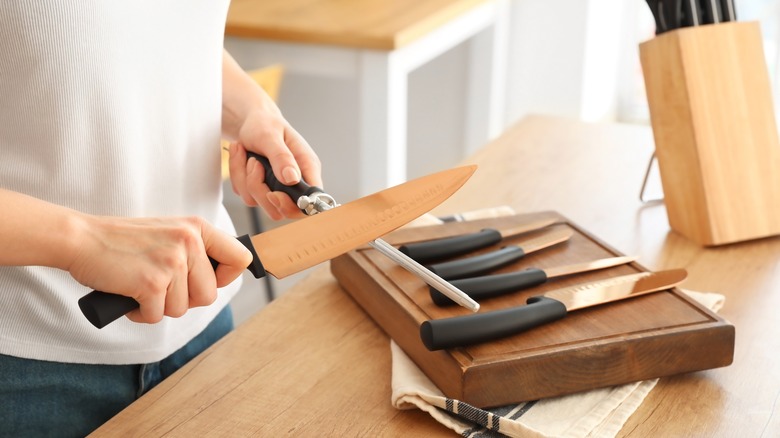Why Drying Is The Most Important Part Of Cleaning Your Kitchen Knives
We may receive a commission on purchases made from links.
Imagine this: You get home after a long day at the office, and it's time for dinner. You whip up an amazing meal. To nobody's surprise, it's five-star quality. Afterward, it's time to wash dishes. Of course, you used your knives — the good ones that sit like decor on your kitchen counter. Like the rest of the night's dishes, you quickly wash them and toss them into your drying rack. Naturally, they'll dry like everything else, right? Very, very wrong.
Your expensive kitchen knives need a specific maintenance routine essential for longevity. Beyond washing them after every use with a blade brush and a sink full of soapy water, drying them properly is a step you can't afford to miss. Whether your knives are stainless or carbon steel, leaving them to air dry can lead to rust, so always dry them by hand promptly. Most tap water is filled with minerals, and extended exposure breaks down the steel. Storing your knives with other wet utensils can also lead to random nicks and cuts on the blades. Take the extra time to dry your knives thoroughly with a clean towel and feel for moisture. Your knives should be bone-dry before you put them away.
What about how you wash them?
How you wash your knives is just as important. First, you should never wash your kitchen knives in the dishwasher. Aside from the chance that your other dishes may get nicked or scraped, detergents can make holes in the steel of your knives. This can cause the coatings to loosen and corrosion to occur. Quality blades are heat-treated. Constantly exposing them to high temperatures in the dishwasher can reverse the initial tempering and make them difficult to sharpen. If washing by hand isn't always possible, it's best to have a row in your dishwasher dedicated to knives. Still, you should be careful because the sharp blades can cut the inside of your dishwasher, leading to rust.
Light discoloration (patina) may form from the oxidation that comes from frequently cutting into apples, onions, or citrus-heavy foods. However, allowing a patina to form on your knife may help solve rust issues. Patina is a thin layer caused by salt and moisture that forms a rust-proof finish on your knife. Unlike rust, patina doesn't continue to spread and has a particular look that differs for every knife. You can speed up this process by leaving mustard or other acid-heavy ingredients on the blade. However, this can be detrimental if done incorrectly, so don't try it if you're not completely sure.
Other maintenance tips
Along with avoiding the dishwasher and promptly drying, there are some other actions you can take to lengthen your knife's lifespan. Though drying is the most important aspect, oiling your knife can help protect it from rust and stray minerals that may be lurking on its surface. Simply apply a thin layer of knife-friendly oil and wipe off any excess with a cloth. As with water, you'll want to dry off any additional residue.
Another great method for preserving your knives is keeping them sharp. Dull knives are more prone to rust because the thinner steel of the blade's edge is less resistant to impact. Even simple acts like dropping your knife in the sink require almost instant resharpening.
Metal polishes are also great for maintaining your knife collection. (They will also give all of your stainless steel appliances the shiniest finish.) If rust has already begun to form, it may not be too late. Grab a rust eraser. With its abrasive surface, you'll be able to scrub away any small spots and begin a proper cleaning routine that will prevent rust from returning. For added protection, store your knives somewhere safe, like in a leather saya.


